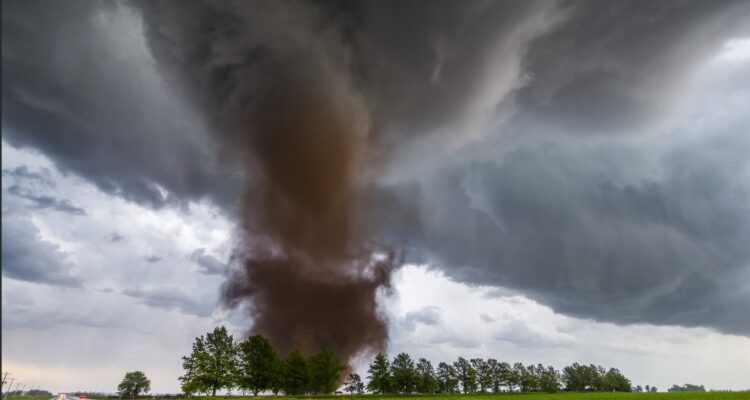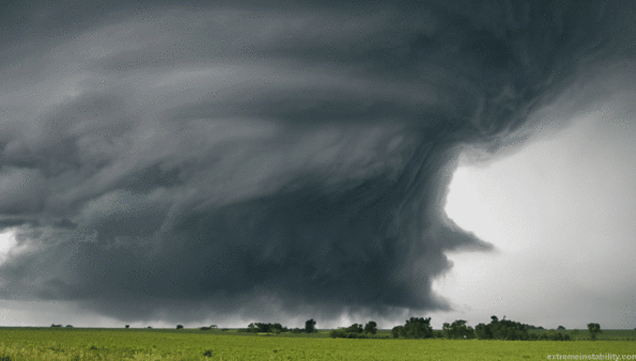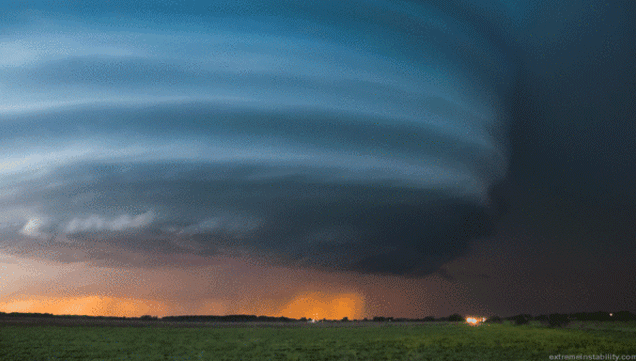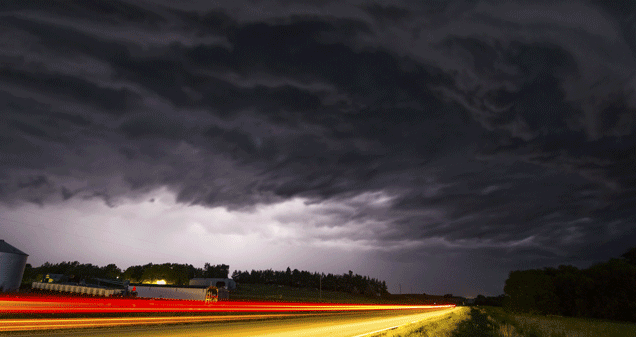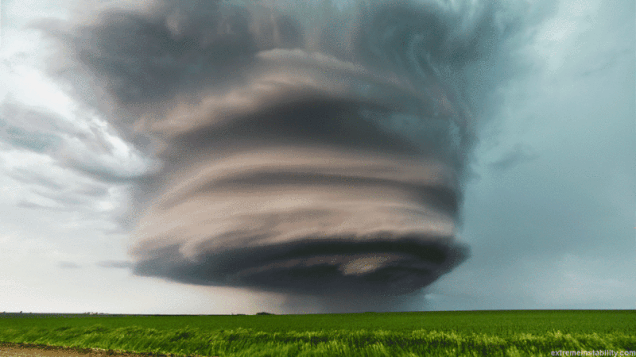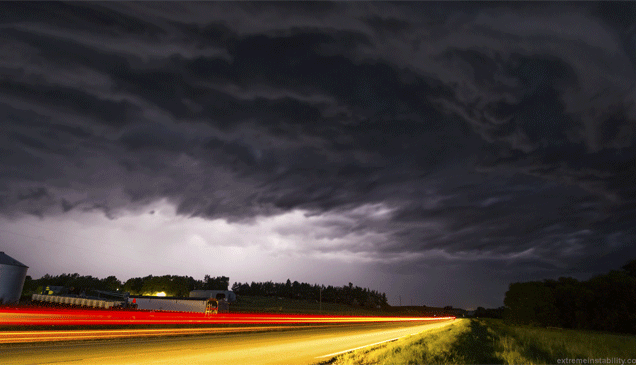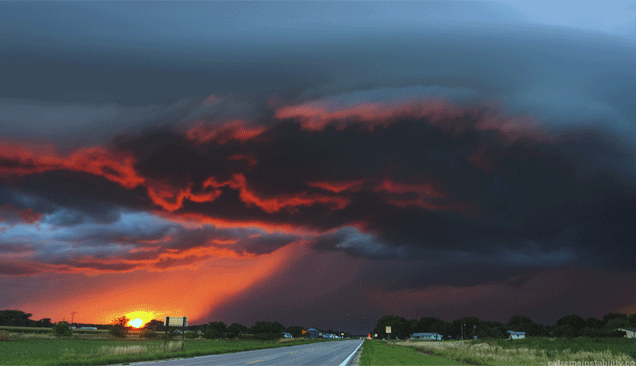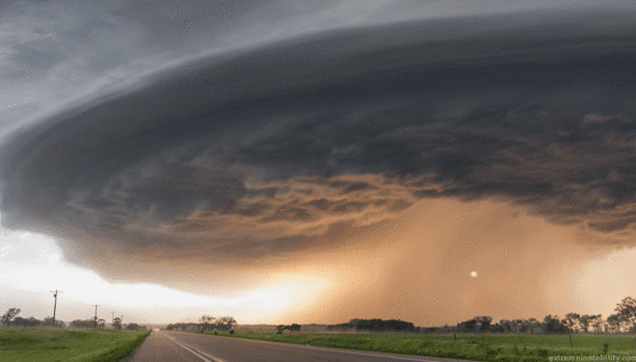
Supercell Storms are amazing natural phenomena. These massive, lumbering storm cells are just impressive to look at in their frozen versions. But take these monstrosities of nature, and then add some semblance of motion that hints as to their lumbering vortex of chaos and the next thing you know you’ve got some jaw-dropping gifs on your hands.
Better yet? These photos were actually not ripped from a video. They were pulled from a single photo and manually animated and built into Photoshop Cinemagraphs. Mike Hollingshead is the genius photographer that shot these photos and did some sweet Photoshop Harry Potter Magic on them to give us these amazing gifs. Well, Mike was kind enough to talk to me about how the heck one lands a life doing this kind of magic and other various random sundries. Personally I’ve never spoken with anyone that made the cover of National Geographic, so there’s that…
Taylor – You have happened to capture numerous once in a lifetime shots in your portfolio. I’m partial to all of them. Your Mammatus shots are amazing. The pictures you took of that Nebraska tornado are unreal. Your morning steam pictures are crazy. They are all fantastic. To keep reproducing these kinds of results there has to be a secret method or process to increasing your chances for stumbling on this stuff. Besides chasing storms, do you have a secret for the rest of us who don’t want to throw ourselves under an oncoming freight train of a storm?
Mike – Well knowing the weather helps a ton obviously. In most circumstances of what I shoot. Helps with the crazy Snow Geese numbers. Helps with those steam ops. But take the low lying fog op for example. There are some small hills/bluffs in western IA. It looks amazing from them when it “seas out” with fog. It’s tricky to get it just right though and not too tall it goes over you or so shallow it is just lame. The point I have here is that I bust on that one sooooooo much. I swear off trying and it takes a lot for me to get to that point. But I never do. And the next chance I’m up at 2 a.m. heading out for the potential. It’s as much about going out a lot as it is knowing when it is worth it.
Chasing storms is that way to a silly degree. Sometimes drive 20,000 miles in a year just chasing storms and only feel what amounts to 1,000 or so miles having resulted in something really worthwhile.
Mike – The original way mentioned just had to do with manually entering opacity amounts for each frame in the layers palette. Depending on number of frames I’d have to figure out what those numbers were then do them one by one. I’d do that with the frames I made and then after all that it would look lame anyway. It was a silly amount of work just to see how it turned out. I at least figured out the way to have a good idea if it was good or not and then to automate the vast majority of the rest in a couple actions. It was a long process of stumbling onto parts to make it all easier and/or to work at all. I’m not guessing there’s an easier way in photoshop but there may be. Given the surprises I always end up seeing there probably is. Then again, maybe not lol.Well anyone that has any art skill it’d likely be amazingly fast to do it. And to do some amazing things. The thing is, I’m horribly bad with art. The ability to draw gets no worse. Design is the same way. So yeah, if I can do that, anyone can. Having the right photo for it is big though. It would be hard to do it so say a line of severe storms. Because they move forward.
Taylor – Is there a storm or a weather system that you haven’t encountered yet that you are dying to get your hands on? What is the White Unicorn in this field?
Mike – I’ve never chased a hurricane but don’t feel a massive desire to. I guess what I really want is a super close, ultrawide angle shot of a tornado. Like crazy close. Like this one. That could have been it. National Geographic used one of those on their cover in 2012. It was probably a half mile away though. My problem is I also shoot video. So I’m trying to do both. I will mount the video camera to the window and then shoot stills. You have to keep moving things and yourself as the tornado closes in though. But change that to just doing video or stills and it would be way easier to drive up to that tornado real close and get shots. Or I need to get more serious with the in car video mount I guess. Of late I’ve thrown in a quad copter drone too lol. Not sure how I’ll manage three things at once in a situation like that. I figure at least the drone has GPS and can just hang once it is up there. Needs to be a way where it follows above your car via a gps device in the car. Anyway, seeing a tornado like that doesn’t feel overly dangerous. Nor would driving up closer. It’s only scary when you are inside a storm(rain) and know there’s likely one in there near you and you want out of there.
Taylor – What did you do before you quit your job to do this full time? What would you have done differently leading into it if you could do it over again?
Taylor – Well thanks a ton Mike for taking the time out to chat. You are just killing it. And I can’t wait to see what you come up with next. Here are a pile more of his amazing storm cell cinemegraphs. And please make sure you check out Mike’s portfolio… and heck, support him by buying a dozen or so of his tutorials. Gotta make sure he doesn’t go back to that plant, God forbid! hahaha.

